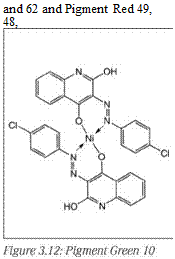In Europe, salt-type azo pigments are known as toners, while in the rest of the world, they are known as lakes. These pigments are formed by precipitating a monazo compound (dyestuff) that contains sulfonic and/or carboxylic acid groups with suitable metal ions such as sodium, calcium, barium or strontium. The acid groups may be carried by aromatic amines or coupling agents. Some important coupling components are 2-naphthol, 2-hydroxy-3-naphthoic acid and
|
|
2-hydroxy-3-naphthoic acid. The shade of the pigment depends on chemical composition as well as the salt used for precipitation. These pigments have improved solvent and migration resistance, but their salt structure makes them vulnerable in terms of chemical resistance. They are economical pigments with high tinting strength and therefore are widely used in printing inks. Some important examples of such pigments (Figure 3.11) include Pigment Yellow 61

 |
52, 53 and 57.
 27 ноября, 2015
27 ноября, 2015  Pokraskin
Pokraskin 
 Опубликовано в рубрике
Опубликовано в рубрике 